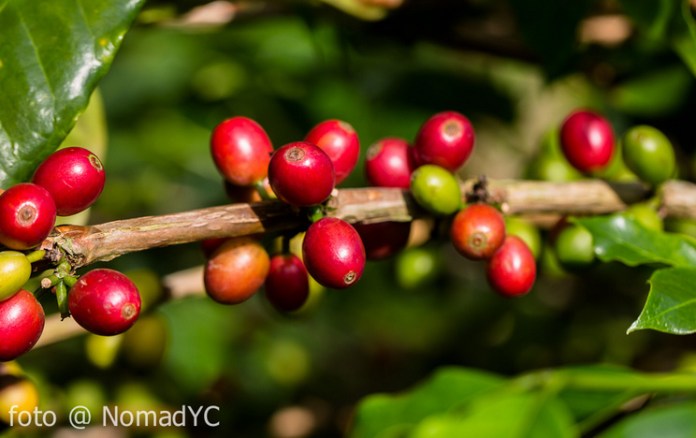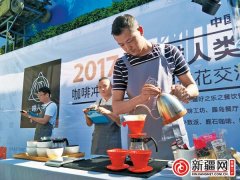A detailed account of the history of coffee cultivation in Taiwan: how does coffee in Taiwan revive after 20 years of loss?

For professional baristas, please follow the coffee workshop (Wechat official account cafe_style)
Coffee is the second largest internationally traded commodity in the world, after oil. Coffee is a very important cash crop in many countries, but in Taiwan, you may have heard the name "Gukeng Coffee". I'm sure you must be very curious. When did Taiwan start growing coffee? And what is the special flavor of coffee produced in Taiwan?
This time, please ask Goat Coffee to elaborate on the growing history of coffee in Taiwan.
Hezhi period
During the great navigation era of 16Murray in the 17th century, the Dutch traveled across the ocean and came to Southeast Asia to expand their colonies, and coffee was also brought to Batavia, Indonesia, by Dutch merchants, who hoped to create considerable economic profits through massive cultivation in the colonies. According to reasonable inference, it is very possible that coffee trees were introduced into Taiwan during the Dutch period from 1624 to 1662, but this has not been documented, so it is still uncertain whether the earliest coffee trees in Taiwan were introduced from the Dutch.
An attempt in the era of clear collar
The earliest clear record of coffee cultivation in Taiwan is the Arabica coffee variety introduced from Manila in 1884 by the British businessman Deji Foreign Company in the Qing Dynasty, which is grown in the seamounts area of New Taipei City and the Wenshan District of Taipei City. However, after three years of planting, it was burned out because of a fire, and the transplanted coffee trees could not adapt to the local climate and environment in Taiwan, so Deji finally gave up growing coffee.
Large-scale cultivation during the Japanese occupation
The real large-scale cultivation of coffee in Taiwan was in the 1930s during the Japanese occupation period, when the Japanese set up agricultural organizations in Hengchun, Chiayi, and Shilin to actively introduce and cultivate coffee, and coffee gradually became an important special cash crop. Local brands such as Taitung Fengtian Village Coffee are more exported to Japan, and the East Taiwan and Kimura Coffee Co., Ltd. was established in 1939. During the introduction of coffee in Taiwan, Li Chunsheng, a famous tea merchant in Tadaocheng, was praised by British officials when he shipped roasted coffee to London, England, in 1935, which was also greatly appreciated by Emperor Taisho of Japan. At that time, it was roughly estimated that the planting area was several hundred hectares.
Planting and international trade after retrocession
However, with the outbreak of the Pacific War, in order to meet the food demand of the war, most of the coffee farmland has been converted to growing rice and other food crops, and Taiwan's coffee industry has gradually declined. It was not until the retrocession that it was restored to Pingtung and Taitung, and gradually cultivated in Nantou, Yunlin, Chiayi, Hualien and Tainan. In the 1950s, Brazil and Colombia produced the largest amount of coffee in the world, while Indonesia was the most prosperous in Southeast Asia. Taiwan's coffee also has a place in Asia, and its quality is on a par with that of Java and other places. in terms of producing area, there are at least 1000 hectares of planting area, most of which are exported to other countries.
However, the good times are not long. With Brazil, Colombia and other Central and South American countries growing coffee in a large-scale and mechanized way, the price of coffee has been greatly depressed, while in Taiwan, because of insufficient production, prices are not competitive, and the government has not taken it seriously. Taiwan's coffee industry has declined again.
In Taiwan's agricultural annual report in 1982, there was no information on the cultivation of coffee. Since then, Taiwan's coffee industry has entered a lost 20 years. During this period, as farmers with experience in growing coffee gradually withered, the technology of coffee cultivation gradually lost. Since the Japanese occupation, the long history of coffee cultivation has to go back to zero.
The revival of coffee in Taiwan
Amazingly, the revival of coffee in Taiwan was caused by the 921 earthquake.
In the 921 earthquake in 1999, the disaster area in central Taiwan was damaged by large-scale landslides and was in great need of soil and water conservation. after research, it was found that a large number of betel nut trees were the culprit of debris flows, so betel nut trees were cut down on a large scale. However, in order to take into account the livelihood of farmers, the government and some people encourage farmers in the disaster areas to plant coffee trees with stronger soil and water conservation capacity than betel nut trees and economic value at the same time. Therefore, at present, many coffee farms in Taiwan are in the state of mixed planting of betel nut trees and coffee trees.
At present, the area of coffee grown in Taiwan is estimated to be about 1500 hectares, and the more famous producing areas include Yunlin Gukeng and Taichung East potential. In 2003, Gukeng coffee was heavily packaged and marketed. At that time, people in Taiwan were very surprised because few people knew that coffee could also be grown in Taiwan. Taiwan's home-grown coffee caused a craze at that time, and it was made and sold in large quantities as instant packaging.
In terms of flavor, including coffee from Gukeng in Yunlin and Dongshi in Taichung, after cup testing, the most common aromas are floral flavor, tea flavor and medium acidity, which is similar to that of alpine coffee in Central and South America. It is speculated that except for similar varieties, Gukeng and Dongshi are all at higher elevations, so they are classified as "mountain type" coffee.
At present, coffee in Taiwan is still mainly sold domestically, one of the reasons is that the domestic market alone is in short supply, and because Taiwan has faded out of the international market for too long, despite its charming flavor, it still takes some time to establish its reputation again. It is worth mentioning that Erna Knutsen, known as the godmother of boutique coffee, came to Taiwan to taste the crystal mineral coffee beans grown and roasted by the "Dashan Crystal Coffee Manor" and praised them.
The cultivation of coffee in Taiwan has such a long history, which is probably beyond the imagination of many people. since the great navigation era, coffee has been connected with Formosa for the first time through the Dutch, and then it was planted in large quantities during the Japanese occupation era. it opened the door to the international export of Taiwan coffee. After the retrocession, Taiwan had a place in the international market by virtue of its high-quality flavor, but it could not resist the price-cutting competition in Central and South America, and finally had to fade out of the market sadly.
After 20 years of loss, Taiwan's coffee industry has revived again, and with its excellent quality, it has once again appeared in front of the world. Although it will take a long time to establish a reputation, we believe that only if we are willing to work hard, coffee beans produced in Taiwan will eventually stand on the international stage again.
Important Notice :
前街咖啡 FrontStreet Coffee has moved to new addredd:
FrontStreet Coffee Address: 315,Donghua East Road,GuangZhou
Tel:020 38364473
- Prev

Is the capsule coffee machine an epoch-making invention or an environmental killer? The inventor said he regretted it.
Professional barista communication Please follow the coffee workshop (official Wechat account cafe_style) what kind of coffee would you like to drink today? Caramel macchiato or American? Put in the capsule and press the button, and in less than a minute, a cup of freshly brewed coffee appears in front of you. However, is there a hidden worry about environmental protection behind the convenience? The invention of capsule coffee in recent years, the hot capsule coffee machine is actually early.
- Next

The first Xinjiang 2017 coffee cup coffee brewing and flower-drawing competition was held in Urumqi.
Communication of professional baristas Please pay attention to the Coffee Workshop (official Wechat account cafe_style) contestant Kuerbanjiang Rexat is making coffee on August 24, the first coffee brewing and flower-drawing competition of the 2017 coffee human cup in Xinjiang was held in Urumqi, more than 30 baristas from all over Xinjiang were brewing on the spot, and the rich aroma of coffee dispersed in the No. 368th Hospital of Changsha Road. In the competition, the contestants
Related
- Why are the coffee in some coffee shops not enough after being frozen? What should I make up for my American latte cappuccino coffee after being frozen?
- How much water does it take to steam coffee by hand? Why is the coffee brewing and steaming time 30 seconds? What is the purpose of steaming coffee?
- The suspected drink contains too much caffeine! Overlord Tea Lady responds urgently!
- Starbucks rejects antique paper coupons?! Netizen: Missed marketing opportunities!
- What ratio of water temperature and ground does the smart cup method use to press coffee? The difference between brewed coffee and filtered coffee?
- What is the standard process for the purpose of coffee cup testing? What is the difference between hand-brewed coffee and cup testing?
- How to use hand-brewed coffee paragon small golden balls? How does cold coffee lock in the aroma of coffee?
- Is American coffee black? What is the difference between American coffee and drip coffee?
- Unexpected! Well-known tea beverage brand Lele Tea will withdraw from the Zhengzhou market!
- Starbucks enters the fashion and beauty industry?! Netizen: Give me an ice American eye cream

